The burden on the Champ is to remain the Champ – or know when to retire before retirement is forced upon you.
The Toyota Prius is still the Champ – and has been the Champ for 20 years’ running.
No other hybrid matches its combination of mileage and cost-to-benefit ratio. Meaning, the cost to buy one isn’t so high that its mileage is economically irrelevant.
Like a Tesla electric car’s.
You can buy one for just over $23k – about the same price as other mid-sized, non-hybrid sedans/hatchbacks and about half the price of a Tesla electric car. Granted, it’s not quick – which a Tesla is. But if quickness is the main criteria (and cost is no object) then economic considerations are irrelevant.
In which case, why not just buy a Porsche? At least you won’t have to plug it in every couple of hours… for a couple of hours.
The Prius also gets nearly twice the mileage of a non-hybrid mid-sized car: Close to 60 MPG in city driving and low 50s on average for the “Eco” version.
And unlike a Tesla or other electric car, it never has to stop for hours to recharge – because it can recharge itself, the hybrid car’s most practical virtue.
The Prius, of course, is Toyota’s famous hybrid, the first hybrid to market (in 1997) and the longest-in-continuous-production hybrid. It’s a mid-sized (almost) five-door hatchback that – even today – hasn’t got any direct competition.
In part because almost all of the other hybrids on the market are afterthought hybrids – i.e., cars that were converted to hybrid powertrains – like the hybrid versions of the Honda Accord and Toyota Camry. The Prius is and always has been a dedicated hybrid – designed from the wheels up to be a hybrid, with no gas-engined sibling.
It is also by far the most fuel-efficient hybrid. Nothing else can get close to 60 MPG that’s not also a moped or a motorcycle.
But unlike a bike, the Prius can carry five people and has 27.4 cubic feet of storage space behind its second row.
Prices start at $23,475 for the base One trim; a top-of-the-line Four Touring stickers for $30,015.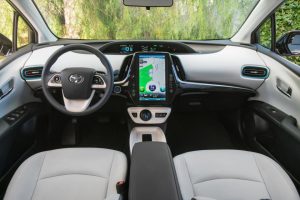
All trims come standard with the same hybrid gas-electric drivetrain but you can buy a max-effort Eco version (available with the step-up Two trim) for $25,165. It ups the mileage from 54 city, 50 highway to 58 city, 53 highway via aerodynamic enhancements and a lower curb weight.
If price is no object – or less of an object – you might cross-shop the Chevy Volt, which isn’t cheap – base price $33,220 – but it is a lot cheaper than a Tesla. And like the Prius, it carries around its own recharger, a small internal combustion engine. The Volt can operate for longer – and faster – on pure electric power, which is cool – but its much higher price moots the economic advantage of that.
WHAT’S NEW
After a complete redesign last year – including an all-new exterior that’s no longer Al Gorean-looking – plus a new high-performance (and lighter and smaller) lithium-ion battery pack in place of the previous nickel-metal hydride unit – the ’17 Prius gets Toyota’s Safety Sense technology suite, which is Joan Claybrookian, as standard equipment in all trims.
The suite includes pedestrian and object detection and automated emergency braking, along with lane departure warning/steering assist . . . god help us all. It is a kind of prequel of the autonomous/self-driving car, which Toyota like everyone else is scrambling to get into production and also get people used to.
WHAT’S GOOD
New lithium-ion battery pack takes up less space, so there’s more room for cargo now – almost 28 cubic feet, or about twice the trunk space of a typical non-hybrid mid-sized sedan.
Uses less fuel than most motorcycles.
Efficient and economical . . . unlike electric cars.
New suit looks good – less obviously hybrid.
New suit is less practical.
There’s almost three inches less legroom in the second row now: 33.4 inches vs. 36 inches for the old model.
Still slow – takes about two seconds longer to get to 60 than the average non-hybrid mid-sized sedan with a four cylinder engine.
It’s no longer as obviously hybrid; some will probably miss that.
UNDER THE HOOD
It’s the same as before – but different.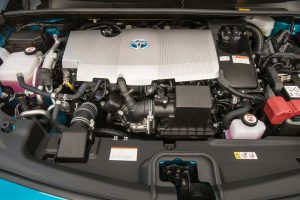
There’s still a 1.8 liter gas-burning engine, a pair of electric motors and a battery pack. All, however, have been revised for greater efficiency. The 1.8 liter four cylinder engine uses exhaust heat to warm up coolant more quickly and this increases the thermal efficiency (now at 40 percent, according to Toyota) of the engine, which in turn reduces its appetite for fuel. The electric motors – one at each front wheel – are redesigned to need less power to propel the car and the battery pack is now a physically smaller but more potent lithium-ion unit, in place of the old car’s nickel-metal hydride unit.
Total output is down slightly – to 121 hp, total (the combined effort of the gas engine and the electric motors/battery pack), vs. 134 for the previous Prius.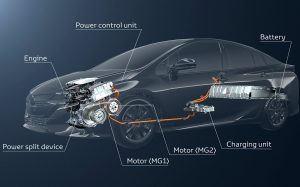
As before, a continuously variable (CVT) automatic transmission is standard, with driver-selectable modes – Normal, Power and EV – controlled by the Prius-trademark toggle shifter mounted on the center stack.
The car accelerates about the same – zero to 60 takes about 9.8 seconds – but the new Prius uses considerably less fuel than the old model. And not just in terms of the published numbers. Which are: 54 city, 50 highway; 58 city and 53 highway for the Eco version, with its aerodynamic enhancements and lower curb weight.
As opposed to 51 city, 48 highway for the previous gen car.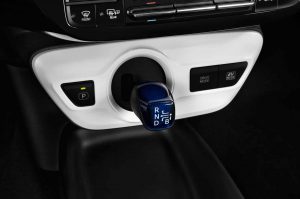
But dinna believe the published numbers. I never averaged less than 56.2 MPG in combined city./highway driving.
Color me impressed . . . with that.
I liked less the built in electric noisemaker that Toyota felt obliged to add for saaaaaaaaaaaaaaaaafety. Or rather, to appease the saaaaaaaaaaaaaafety nags. It comes on from rest to 15 MPH, to alert the sail fawn-addled dolts that a car is rolling in their vicinity and not to step into its path. No more silent drive. No more being able to use the car to sneak up, incognito.
It cannot be heard inside the car, though.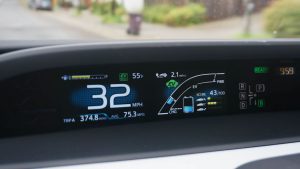
Toyota also saw fit to make standard all the Safety Nags and Electronic Idiot Proofing mentioned in the preface – including the very debatably “safe” steering assist that tries to nudge the car back into the lane you’re in when you attempt to change lanes without signaling first. Yes, I know, you’re supposed to always signal before turning. But that’s like always coming to a complete stop at every stop sign before proceeding – even when it’s absolutely certain there is no other traffic anywhere near. In which case, it is not necessary – ergo stupid – to stop completely. It wastes gas and it wastes time. Signaling for no reason is stupid, too.
Luckily, most of this business can (for now) be turned off.
ON THE ROAD
The Prius has never been speedy but it will go almost forever on a fill-up and that has long been its chief virtue and main sell.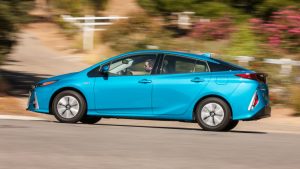
And – per the above numbers – the actual mileage of the car is better than advertised. I have, in the course of almost 25 years of test driving new cars and writing about the results – only been able to say this about one other car.
Well, one other engine.
VW’s TDI diesel engine – whether installed in a Jetta or a New Beetle – always did better than the EPA said they would. With me driving.
Not doing the speed limit.
Ever.
If I could help it.
Well, same here.
Only, better.
56.7 MPG. Really. That’s incredible. As in – I wouldn’t believe it had I not experienced it myself. This was achieved without really trying. Not “hyper-miling.” Running 70-plus. Full throttle (well, full drive-by-wire) starts.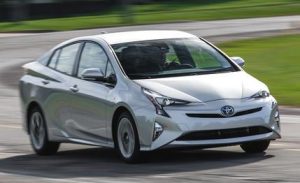
I think you’d need to punch some pinholes in the tank – or pour baking soda on the battery pack (whatever fritzes out lithium ion) to get it under 50, which I often did in the old Prius. It got good mileage – mid-high 40s on average, usually. But never spectacular, like this. The ’17 Prius uses less gas than four of my five motorcycles – and the one that uses less (my 1983 Honda GL650) only uses slightly less gas.
Besides which, the Honda only seats two (uncomfortably) and is a crappy way to get around when its raining or 20 degrees outside.
The Prius is warm and dry inside. It can carry five people.
And it goes much farther, too. The bike can go maybe 200 miles on a (small) tank before it’s on reserve. The Prius can go more than 600 miles before it needs a refill. And that refill only takes 5 minutes – just like any regular car. And unlike the politically correct but functionally idiotic electric cars being glad-handed by a media congenitally disposed to not telling the truth about them. Which is that even when hooked up to high-volt “fast” chargers that are not commonly available, the fastest they recharge – partially recharge, to maybe 75-80 percent – is about 30-45 minutes. If no fast charger is available and all you’ve got handy is a 115V household outlet, it is hours.
With an electric car, you plan your driving around the car’s limitations. With the Prius, you just go for a drive.
I mentioned that it is not quick. But traffic is generally slow. If you are an alert driver, it is no problem to get through and around – and even outpace – the general cattle call. When the light goes green, not much happens. People – most of them – seem to need a few moments to process the fact, then react. If you don’t, you’ll already be moving while they are still standing still – regardless of the fact that they may have more horsepower.
That only matters if people use it.
Most don’t. Take advantage of the fact and you will not miss the horsepower you don’t actually need.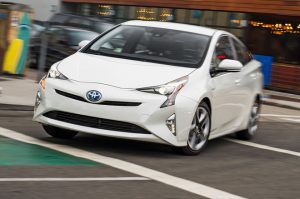
Handling: It is better than before, the result of a new double-wishbone suspension in place of the old car’s torsion beam set-up. It is still easy to squeal the tires in a curve because they are tiny (for a modern car) 15×6.5 inchers and low rolling resistance, designed to be as friction-free as reasonably doable, for the sake of mileage. But the car itself feels much less sloshy. The new suspension is part of it and also the lower center of gravity, lower curb weight and lower ride height (5.1 inches off the pavement now vs. 5.3 previously).
The ’17s more aerodynamic profile (0.24 CD vs. 0.25 before) also reduces wind noise at speed.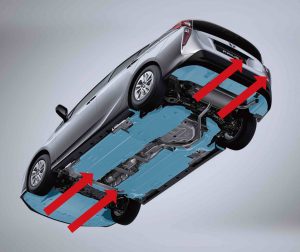
Though the new car is 2.4 inches longer overall, the turning circle has been tightened up by almost a full foot to 33.5 feet vs. 34.2 feet for the old Prius. That plus ultra-light electric-boosted power steering makes it exceptionally easy to maneuver in close quarters, such as parallel parking on busy city streets.
All of the Idiot Proofing mentioned earlier is not needed in this car – if it is needed in any car.
This includes, in particular, the preposterous back-up buzzer that erupts for saaaaaaaaafety whenever the gear selector is placed into Reverse. Being pestered by a buzzer while trying to back-up is arguably more of a genuine safety hazard than any putative risk the buzzer is supposedly there to minimize.
AT THE CURB
This is the first Prius that doesn’t look like one.
All the previous ones did. It was part of the appeal, too. First, because the car was something really different for many years after its first appearance in the late ’90s. A hybrid car? Wow! Cool! People liked to advertise the fact in the same way that, a long time ago, people liked to advertise how many cubic inches they were packing under the hood.
There was also a kind of snob appeal. The Prius made a statement. I am green. The ungainly, slightly odd-looking thing proudly carried the flag.
Later, rival hybrids like the hybrid Civic of the 2000s (RIP) didn’t look obviously different; it was harder to tell it was a hybrid – because it looked more or less like an ordinary car.
There was less green appeal.
That may account for some of the reason why the Hybrid Civic and others like it didn’t sell as well.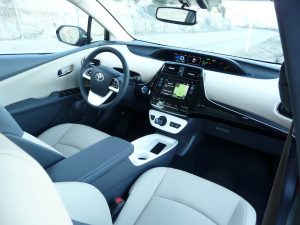
At least, when hybrids were a novelty.
Today they are not. Everyone – literally – sells one. The others may not be dedicated hybrids like the Prius, but the fact remains. The novelty has worn off.
So Toyota did a turnabout and decided to make the latest Prius look not-like a hybrid.
Not obviously, anyhow.
Instead, it looks like the latest medium-small sporty hatchback; the hybrid part being visually incidental. This makes sense in an evolutionary sense, too. Hybrids are no longer new. Form doesn’t have to follow function to the same extent it once did. Think about the evolution of cars generally – from the earliest models of 100 years ago that still looked clumsy and a lot like horse-drawn carts – to subsequent models. It took time to smooth out the lines, to make the parts smaller.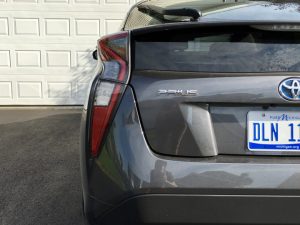
Same here.
Because the the battery pack takes up less space and the other parts are also smaller and more efficient, the car can be packaged differently. Made to look sexier, too. Note the low cut door-side glass, which swoops interestingly down and forward.
There is substantially more cargo room now, too – and a bit more headroom in both rows and more legroom up front (43.2 inches).
There’s one gnarly pube in the soup, though.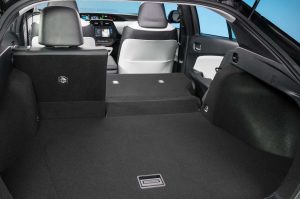
The 2017 has significantly less backseat legroom than the previous generation Prius: 33.4 inches vs. 36 inches before the makeover. It’s a big difference and hard to understand why it was done. The Prius has gone from having a mid-sized car’s backseats to a compact car’s backseats.
And that’s not a sell.
THE REST
All trims get urethane or what Toyota styles SofTex synthetic leather that has temperature-regulating properties; it feels cooler to the touch in summer and warmer to the touch in winter.
Eco trims get exterior glass that treated to reflect infra-red solar radiation, reducing the load on the AC system – which in all trims is driven electrically and is also “smart.” It can sense whether anyone’s sitting in the passenger seat and if no one’s there, it doesn’t waste airflow on the non-person not sitting there.
The car offers automated self-parking, both parallel and perpendicular. But as interesting as this is from a wow! look what it can do! technological/engineering perspective, anyone who can’t competently park a medium-small hatchback with excellent visibility on their own is a menace to other drivers and shouldn’t be driving at all.
No one in the car press talks about this except me.
They should.
THE BOTTOM LINE
The Champ hasn’t gotten old and flabby.
Like Stallone in Rocky IV, it’s got an eight pack now.
If you like what you’ve found here, please consider supporting EPautos. (Latest radio guest appearance can be heard here.)
We depend on you to keep the wheels turning!
Our donate button is here.
If you prefer not to use PayPal, our mailing address is:
EPautos
721 Hummingbird Lane SE
Copper Hill, VA 24079
PS: EPautos stickers are free to those who send in $20 or more to support the site. 





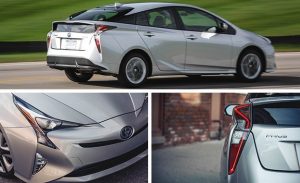
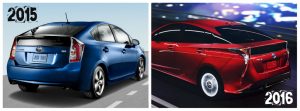
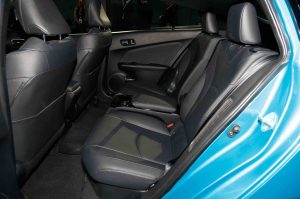
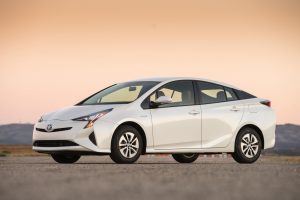






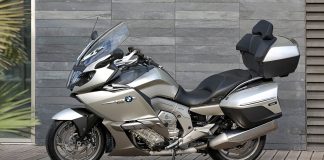
Eric,
I would have sworn that the Honda Insight was the first hybrid car, but I looked it up and found that I was partially right: Insight was first hybrid sold in America, as first gen Prius was only sold in Japan.
Being tall I get really pissed off about legroom issues: decreasing rear-seat legroom so they can say the car has more cargo capacity, and not letting front seat go further back, just to save money, by using shorter seat floor rails – Double UGGGH!
Hi Charlie,
I got to drive the original Insight two-seater; it was a neat little commuter that achieved, IIRC, 60-plus MPG on average. Something like this makes sense to me, economically and practically.
Electric cars, on the other hand…
Oh my. That is ugly. But I could have used one last summer when I was driving 400 miles a day 7 days a week.
Whatever happened to long term reports of the battery pack? How long do they last? How expensive are they to replace? Can a DIY’er perform the replacement? The tech has appeal, but all that stuff breaks, man. The more I go around cars, the more I want them to be low tech. (bare bones work trucks being the only currently available type of this..)
Many people are wondering what’s happened to Prius sales. You may say cheap gas, but the fact that it’s about the ugliest car I’ve ever seen has to be a major factor.
I’m a car guy, and I do see the beauty in amazing mechanical designs, and the Prius’s hybrid system and transmission (which work together, it doesn’t have a real CVT), simply blow my mind. It’s one of the most elegant mechanical systems I’ve ever seen. The “transmission” is a planetary gear set with the gas engine turning the carrier plate, and the two motor/generators turning the sun and planet gears.
What the car electronics do is figure out how much gasoline power to generate, and set the gasoline engine to output that much. Then, they know how fast to make the car go, and use the two electric motors to directly spin the gear as those speeds. If they want to recharge the batteries, they run the engine harder than needed to go that fast, and use one or both of the generators to “brake” the engine, generating electricity in the process. Since they have so much electric torque available, they can use a Atkinson cycle engine, albeit one which fakes the Atkinson cycle, which are more efficient than the more common Otto cycle, with the downside being that they have much less low-end torque. That’s ok, if you have electric motors to supplement.
It’s a brilliant design. I’d love to see a version of it in a different kind of car, something like an FR-S.
Agreed, Opposite!
And: Imagine this technology in car that weighed 1,000 lbs. less…
Eric: Thanks for the effort. I have wanted an EV for over thirty years. I almost bought a Prius in the ’90s (in a weak moment) but did the math and found it not competitive with the ICE. I have gotten sick all my life when exposed to diesel fumes so that was out. When the Hybrids finally to competitive, I had upped my standards for EVs so I waited for a serious one. Then came the Aptera. It did it all. The two fundamentals were maximized: 1. Low weight (about 1700lbs). 2. Low drag, D.C. of .15. It set the “gold standard” for EVs. I am still waiting for something close to it, knowing I will probably die first. If I do give in and compromise, I will probably buy the Prius. My ’08 Camry V6 has 110K, my ’95 Camry V6 had 256K when sold.
I consider these hybrids as “gas-vehicles with electric assist”, but my wife won’t accept a BEV, like the Tesla.
You bet, Voluntaryist!
I’m not a huge fan of cars like this, either. But it at least can make an economic case for itself. For that, I give it some credit.
This car is for the Al Gore worshippers who think of a car as an appliance and are waiting anxiously for autonomous vehicles. It’s also uglier than my dead Grandfather in a thong.
Hi Doug,
Yeah, but the old one was worse!
Hi Eric!
As always, you are most adept in finding the positive in today’s automotive offerings. Th fact that the manufacturers don’t even pay you for for time, is further proof of you unbiased objectivity. I wish I could say the same for myself. While performing the VA Safety Inspection, for example, I don’t get extra pay for trying to resolve how to check exhaust pressure on a vehicle that won’t run the IC engine without throttle input from the accelerator. Since I fly solo here, my solution is usually what I call the “Prius Dash”, to get to the tailpipe 2.5 seconds before the motor shuts off. Se la vive’.
Hi Graves,
THat’s a good one – about the inspection! Hadn’t thought about it, but absolootely. Cars like this are not my personal cup of tea, but then, few new or recently made cars are. I’d review a Challenger SRT8 every week, if I could… 🙂